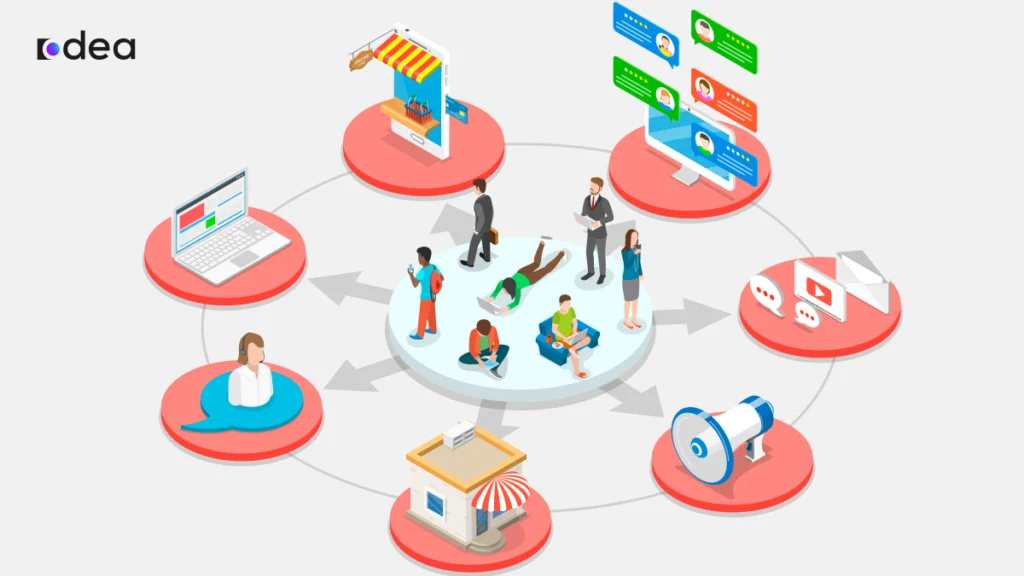Contact Center and Customer Experience (CX) solutions have become vital for business success in today’s fast-paced and competitive market. As customer expectations continue to evolve, businesses are under immense pressure to deliver seamless, personalized experiences at every point of interaction.
To meet these demands, companies require advanced technologies that not only streamline operations but also enhance customer satisfaction.
This is where Odea Integration stands out, offering intelligent, integrated solutions designed to help businesses navigate the complexities of modern customer experience management.
With cutting-edge AI-driven capabilities, omnichannel communication, and robust analytics, Odea Integration empowers companies to improve customer support, increase retention, and foster long-term loyalty.
In this article, we’ll delve into why Contact Center and CX solutions are essential for driving business growth, and how Odea Integration equips organizations to harness these technologies for lasting success.
Understanding Contact Center and CX Solutions
What Is a Contact Center?
A contact center is much more than just a place where customer calls are answered. It’s an integrated platform where businesses manage interactions across multiple channels—phone, email, chat, social media, and more.
Modern contact centers are powered by advanced technology such as AI, CRM integration, and cloud-based solutions, all of which help businesses elevate their customer service operations.
One of the most transformative developments in this space is Contact Center as a Service (CCaaS)—a cloud-based model that enables businesses to scale effortlessly, cut operational costs, and tap into powerful features like AI, analytics, and omnichannel communication without the complexity of traditional infrastructure.
To explore how CCaaS is reshaping customer service operations, read this in-depth article that outlines its key benefits and how it fuels business growth.
With these tools, agents can respond quickly to customer inquiries, resolve issues, and foster long-term relationships that build loyalty.

What Are CX Solutions?
Customer Experience (CX) solutions encompass the entire customer journey, from initial contact to post-purchase support. They ensure that every customer interaction is smooth, personalized, and relevant.
CX solutions go beyond simple problem-solving; they are about creating experiences that delight customers at every stage.
Odea Integration specializes in providing seamless CX solutions that integrate CRM systems, omnichannel communication, AI-driven automation, and real-time analytics, enabling businesses to stay ahead of customer expectations.
Why It Matters: The Business Value of CX
The value of investing in CX solutions cannot be overstated. According to research, 70% of customers say they remain loyal to brands that offer personalized experiences.
Additionally, companies that invest in advanced CX solutions report a 30% increase in retention rates. Here’s a deeper look at how CX impacts business outcomes:
- Customer Loyalty
Delivering exceptional customer experiences builds trust, and trust is a key driver of loyalty. Loyal customers not only return but often become brand advocates, recommending your products and services to others. This word-of-mouth marketing is invaluable in today’s digital world. - Higher Retention Rates
Retaining existing customers is more cost-effective than acquiring new ones. A smart CX strategy helps businesses reduce churn by providing fast and efficient solutions to customer issues.
Proactive service, like offering helpful tips and product recommendations, enhances the overall experience and keeps customers coming back. - Stronger Brand Reputation
Customer service is often the first touchpoint for a customer with a brand. Delivering superior service creates positive word-of-mouth, leading to strong reviews and a stellar brand reputation.
Social media has amplified this impact, making it easier for satisfied customers to share their experiences with a wide audience. - Improved Customer Lifetime Value
When customers feel valued, they are more likely to make repeat purchases. Personalized service, whether it’s offering tailored promotions or addressing specific customer needs, increases the likelihood of continued spending over time.
This leads to higher customer lifetime value (CLV), which is crucial for sustained business growth.
Odea Integration provides businesses with the tools to unlock these benefits by delivering tailored CX solutions that align with each industry’s unique needs. Whether you’re in e-commerce, healthcare, finance, or any other industry, Odea Integration offers scalable solutions that drive customer satisfaction and business success.
Industry Applications: How CX Solutions Improve Operations
Contact Center and CX solutions have a profound impact on operations across different industries. Here are a few examples of how Odea Integration helps businesses enhance their customer experience:
- E-Commerce: Real-time chat support, personalized product recommendations, and efficient returns processes all contribute to a seamless shopping experience.
Odea Integration helps e-commerce businesses integrate these tools to provide quick and helpful responses to customer inquiries, improving satisfaction and driving sales.
- Healthcare: Patient care is at the heart of the healthcare industry. Secure contact centers enable healthcare providers to manage appointments, patient concerns, and follow-ups while ensuring HIPAA compliance. Odea Integration helps healthcare providers streamline communication, allowing them to focus more on patient care.
- Telecommunications: Telecommunication companies often face high volumes of service inquiries and technical issues.
By implementing omnichannel support systems, Odea Integration helps telecom businesses resolve issues quickly and efficiently, boosting customer satisfaction and reducing operational costs.
- Financial Services: Financial institutions need to offer personalized assistance while maintaining security and regulatory compliance.
Odea Integration enables financial businesses to integrate CX solutions that provide customers with customized support, from billing inquiries to financial advice, all while ensuring the protection of sensitive data.
- Travel and Hospitality: AI-powered cloud contact centers are transforming customer experiences in the travel and hospitality industry by leveraging automation, real-time analytics, and omnichannel capabilities. Virtual agents manage routine inquiries, allowing human agents to focus on more complex needs.
To learn more, explore our full article How AI-Powered Cloud Contact Centers Are Shaping the Travel and Hospitality Industry in 2025.
- Higher Education: AI-powered cloud contact centers are transforming student support in universities and colleges by managing inquiries efficiently across multiple channels.
Chatbots handle common questions, while human agents focus on complex issues, enhancing the student experience. Real-time analytics and omnichannel tools help institutions streamline operations.
To explore more, check out our full article on How AI-Powered Cloud Contact Centers Are Revolutionizing Student Support in Higher Education.
These industry-specific applications demonstrate how Odea Integration’s solutions can be customized to meet the unique needs of different sectors, helping businesses stay competitive while enhancing their customer experience.

The Tools That Power Exceptional CX
To deliver outstanding customer experiences, businesses need the right tools and technologies in place. Odea Integration provides a comprehensive suite of solutions that include:
- Omnichannel Platforms
A successful contact center integrates multiple communication channels—voice, chat, social media, email—into one cohesive platform. This allows agents to provide personalized service with a complete context of the customer’s interactions, leading to faster and more efficient resolutions.
- AI & Automation
AI-powered tools like chatbots and virtual assistants help businesses manage repetitive tasks, streamline workflows, and reduce response times. These technologies allow agents to focus on more complex customer needs, improving efficiency and customer satisfaction.
- CRM Integration
CRM systems, like Salesforce, provide businesses with valuable customer insights, including purchase history, preferences, and past interactions. By integrating CRM systems with telephony and communication platforms, businesses can offer more personalized and efficient service.
- Analytics & Insights
Data-driven decision-making is critical to refining customer experience strategies. With advanced analytics, Odea Integration helps businesses track customer behavior, predict trends, and continuously optimize their CX strategies based on real-time feedback.
Common Pitfalls—and How to Avoid Them
Contact Center and Customer Experience (CX) solutions have become vital for business success in today’s fast-paced and competitive market. As customer expectations continue to evolve, businesses are under immense pressure to deliver seamless, personalized experiences at every point of interaction.
To meet these demands, companies require advanced technologies that not only streamline operations but also enhance customer satisfaction.
This is where Odea Integration stands out, offering intelligent, integrated solutions designed to help businesses navigate the complexities of modern customer experience management.
With cutting-edge AI-driven capabilities, omnichannel communication, and robust analytics, Odea Integration empowers companies to improve customer support, increase retention, and foster long-term loyalty.
In this article, we’ll delve into why Contact Center and CX solutions are essential for driving business growth, and how Odea Integration equips organizations to harness these technologies for lasting success.

How Odea Integration Makes the Difference
At Odea Integration, we don’t just provide software solutions—we create comprehensive CX ecosystems that empower businesses to thrive. Here’s how we help our clients:
- Tailored Integrations: We design custom integrations that align with your business objectives, ensuring that every solution meets your specific needs.
- AI-Powered Tools: Our AI-driven solutions enhance agent efficiency, reduce response times, and improve customer satisfaction.
- 360° View of the Customer: By eliminating data silos, we give businesses a complete view of the customer, enabling them to deliver personalized service every time.
- Consistent Service Across Touchpoints: We ensure that every customer interaction is aligned with your brand’s values and goals, building long-term relationships.
Whether you’re upgrading your contact center, integrating Salesforce with your communication systems, or implementing a full omnichannel solution, Odea Integration has the expertise and tools to help you succeed.
Conclusion: The Future of CX is Now
As customer expectations continue to rise, businesses must take decisive action now to stay ahead of the competition. By adopting advanced Contact Center and CX solutions, companies can build long-lasting relationships with their customers, reduce churn, and drive sustainable growth.
At Odea Integration, we provide you with the cutting-edge tools you need to enhance your customer experience strategy to meet the demands of the digital age. Whether you’re upgrading your contact center or looking for a comprehensive omnichannel solution, we’re here to support you every step of the way.
Get in touch with us today to start your journey toward transforming your customer experience. With Odea Integration, the future is now in your hands





